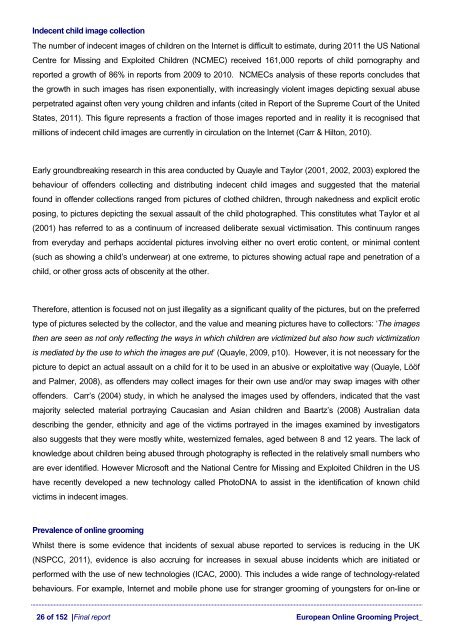Final Report - European Online Grooming Project
Final Report - European Online Grooming Project
Final Report - European Online Grooming Project
You also want an ePaper? Increase the reach of your titles
YUMPU automatically turns print PDFs into web optimized ePapers that Google loves.
Indecent child image collection<br />
The number of indecent images of children on the Internet is difficult to estimate, during 2011 the US National<br />
Centre for Missing and Exploited Children (NCMEC) received 161,000 reports of child pornography and<br />
reported a growth of 86% in reports from 2009 to 2010. NCMECs analysis of these reports concludes that<br />
the growth in such images has risen exponentially, with increasingly violent images depicting sexual abuse<br />
perpetrated against often very young children and infants (cited in <strong>Report</strong> of the Supreme Court of the United<br />
States, 2011). This figure represents a fraction of those images reported and in reality it is recognised that<br />
millions of indecent child images are currently in circulation on the Internet (Carr & Hilton, 2010).<br />
Early groundbreaking research in this area conducted by Quayle and Taylor (2001, 2002, 2003) explored the<br />
behaviour of offenders collecting and distributing indecent child images and suggested that the material<br />
found in offender collections ranged from pictures of clothed children, through nakedness and explicit erotic<br />
posing, to pictures depicting the sexual assault of the child photographed. This constitutes what Taylor et al<br />
(2001) has referred to as a continuum of increased deliberate sexual victimisation. This continuum ranges<br />
from everyday and perhaps accidental pictures involving either no overt erotic content, or minimal content<br />
(such as showing a child’s underwear) at one extreme, to pictures showing actual rape and penetration of a<br />
child, or other gross acts of obscenity at the other.<br />
Therefore, attention is focused not on just illegality as a significant quality of the pictures, but on the preferred<br />
type of pictures selected by the collector, and the value and meaning pictures have to collectors: ‘The images<br />
then are seen as not only reflecting the ways in which children are victimized but also how such victimization<br />
is mediated by the use to which the images are put’ (Quayle, 2009, p10). However, it is not necessary for the<br />
picture to depict an actual assault on a child for it to be used in an abusive or exploitative way (Quayle, Lööf<br />
and Palmer, 2008), as offenders may collect images for their own use and/or may swap images with other<br />
offenders. Carr’s (2004) study, in which he analysed the images used by offenders, indicated that the vast<br />
majority selected material portraying Caucasian and Asian children and Baartz’s (2008) Australian data<br />
describing the gender, ethnicity and age of the victims portrayed in the images examined by investigators<br />
also suggests that they were mostly white, westernized females, aged between 8 and 12 years. The lack of<br />
knowledge about children being abused through photography is reflected in the relatively small numbers who<br />
are ever identified. However Microsoft and the National Centre for Missing and Exploited Children in the US<br />
have recently developed a new technology called PhotoDNA to assist in the identification of known child<br />
victims in indecent images.<br />
Prevalence of online grooming<br />
Whilst there is some evidence that incidents of sexual abuse reported to services is reducing in the UK<br />
(NSPCC, 2011), evidence is also accruing for increases in sexual abuse incidents which are initiated or<br />
performed with the use of new technologies (ICAC, 2000). This includes a wide range of technology-related<br />
behaviours. For example, Internet and mobile phone use for stranger grooming of youngsters for on-line or<br />
26 of 152 |<strong>Final</strong> report <strong>European</strong> <strong>Online</strong> <strong>Grooming</strong> <strong>Project</strong>_


